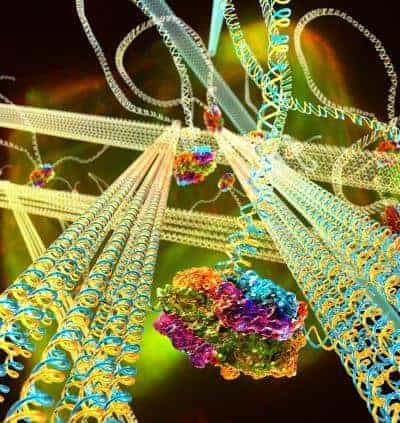A team of researchers have shown that schizophrenia and a disorder associated with autism and learning difficulties share a common biological pathway. This is one of the first times that researchers have uncovered genetic evidence for the underlying causes of schizophrenia.
The team found that a disruption of the gene TOP3B, an exceedingly rare occurrence in most parts of the world, is fairly common in a uniquely genetically distinct founder population from North-eastern Finland. In this population, which has grown in relative isolation for several centuries, the disruption of TOP3B is associated with an increased risk of schizophrenia as well as with impairment in intellectual function and learning.
Furthermore, the biochemical investigation of the protein encoded by the TOP3B gene allowed the researchers to gain first insight into the cellular processes that might be disturbed in the affected individuals.
Although the past two decades have revealed a wealth of information about the genetics of disease, we still know little about the biology behind schizophrenia. Many associations between schizophrenia and genetic risk factors have been reported, but only a very few can be considered schizophrenia susceptibility genes. This study uncovers an important biological pathway that appears to underlie schizophrenia and could contribute to the cognitive impairment that is an important component of this disorder.
“This is a tremendous discovery for our team; not only have we uncovered vital information about the biology behind schizophrenia, but we have also linked this same biological process to a disorder associated with learning difficulties,” says Dr Aarno Palotie, lead author from the Wellcome Trust Sanger Institute, the Broad Institute of MIT and Harvard and the Institute for Molecular Medicine Finland. “Our findings offer great hope for future studies into the genetic basis of schizophrenia and other brain disorders, potentially finding new drug targets against them.”
The North-eastern population of Finland has three times the frequency of schizophrenia compared to the national average in Finland, as well as a higher rate of intellectual impairment and learning difficulties. The team used data collected from this unique population to sift through genomic data for genetic deletions that may influence people’s susceptibility to schizophrenia.
The team identified a rare genetic deletion affecting TOP3B in the North-eastern Finnish population that increases a person’s susceptibility to schizophrenia two-fold and that also is associated with an increased frequency of other disorders of brain development such as intellectual impairment. They speculate that this deletion directly disrupts the TOP3B gene to cause its effects on the brain.
Having identified the link between TOP3B and schizophrenia, the researchers sought to understand why disrupting this gene might increase susceptibility to disease, and for this purpose they investigated the function of the protein that it encodes.
“Such an approach is only possible when researchers from different disciplines – in our case geneticists and biochemists team up,” says Professor Utz Fischer, author from the University of Wurzburg. “Luckily, when we teamed up with the genetic team we had already worked on the TOP3B gene product for more than 10 years and hence had a good idea what this protein is doing”.
TOP3B encodes a type of protein that typically helps the cell to unwind and wind DNA helices – essential to normal cell function. Quite unexpectedly for an enzyme of this class, however, TOP3B was found to act on messenger-RNA rather than DNA.
In their further biochemical investigation into TOP3B, the team found that the TOP3B protein interacts with a protein known as FMRP. The deactivation or disruption of this protein is responsible for Fragile X syndrome, a disorder associated with autism and learning difficulties, primarily in men.
Within the northern Finnish population, the team identified four people who did not have a functioning copy of the TOP3B gene. These four people were either diagnosed as having learning difficulties or as having schizophrenia, solidifying the evidence that this gene is important in these brain disorders and that they are biologically linked.
“These two disorders, schizophrenia and Fragile X syndrome, although they may seem drastically different, share key features, particularly the cognitive impairment that is frequently associated with both conditions,” says Dr Nelson Freimer, author from UCLA. “So, it is not unexpected that they could share some of the same biological processes.
“What is fantastic about this study is that through investigations in an isolated corner of Finland we are contributing to concerted international efforts that are beginning to unravel the genetic root of schizophrenia, a debilitating disorder that affects so many people throughout the world.”


